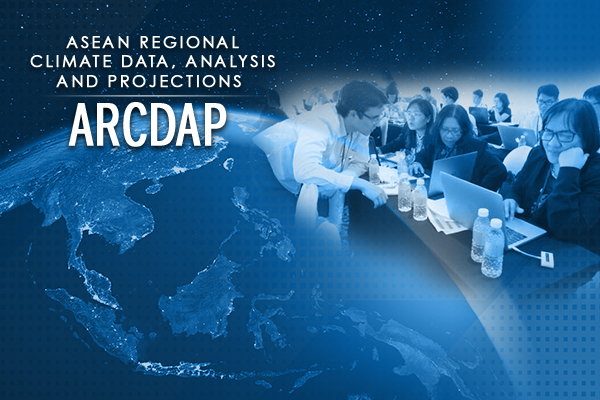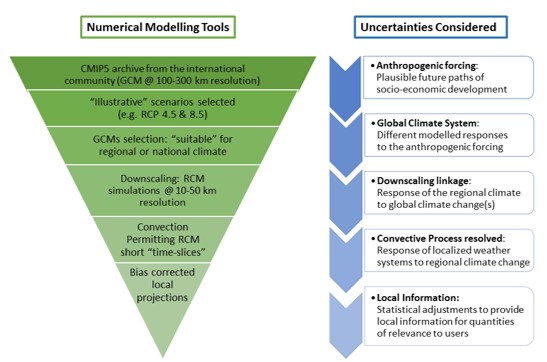01 MAR 2018
Workshops, Climate Projections
First Workshop on ASEAN Regional Climate Data, Analysis and Projections (ARCDAP-1)

Date: 20 MAR 2018 - 23 MAR 2018
Venue: Village Hotel Bugis, Singapore

Background
It is recognised that Southeast Asia is a region with important sensitivities to climate variability and change. Many countries in the region have developed climate change projection scenarios to be used in the formulation of national adaptation plans. In many cases the starting point is regional wide scenarios, either from the Global Climate Models (GCMs) employed in the Intergovernmental Panel on Climate Change (IPCC) or from bespoke statistical or dynamical regional climate downscaling studies; thus the opportunity to examine regional and local uncertainties pertinent to developing national climate change scenarios, as illustrated below. In addition to the climate scenarios that provide future ranges of quantities such as temperature, rainfall, wind, and sea level rise, many studies across the region consider the multi-sector impacts and implications for adaptation planning.

Schematic illustrating the modelling tools relied upon to deliver typical national climate change projections (left) and the uncertainties considered (right) as finer numerical modelling tool are relied upon (source: “Generating Climate Change Rainfall Scenarios for Singapore; A Tale of Scale”, by M.E. Hassim et al., COSMOS Research Highlights, 2017).
To date no attempt has been made to compare and contrast the various studies for the region and to define guidelines for best practices in the generation of these scenarios. In most cases these studies are at the national level and it will be beneficial for countries in the region to share their experience, with a view to develop best practice guidelines. This is important because of the large uncertainties in the climate projections themselves and establishing best practices in how to represent these uncertainties in downstream impacts is not straightforward.
In recognition of the above, the WMO RA V Working Group on Climate Services (WG-CLS) proposed the conduct of a workshop to review climate scenarios for the region as well as the methodologies and challenges in their use in impact studies and the formation of adaptation policy. It is proposed to consider Southeast Asia as a whole which therefore includes countries in both RA V and RA II. This is an appropriate arrangement due to the common climatological features of the region and it follows the leads of previous or existing initiatives to coordinate regional climate change projection efforts, which are:
- The Southeast Asia Climate Analysis and Modelling (SEACAM) framework was initiated in 2011 by CCRS in Singapore in collaboration with regional National Meteorological and Hydrological Services (NMHSs) and research institutes as well as the UK Met Office Hadley Centre. SEACAM’s objectives were to enhance regional scientific cooperation and increase scientific capacity among climate researchers in the Southeast Asia region through workshops and collaborative projects in the areas of regional climate analysis and modelling. It delivered a series of four workshops between 2011 and 2014 and made used of high resolution regional simulations (25 km) using the UK Met Office’s PRECIS model forced with CMIP3 GCMs.
- The Regional Climate Projections Consortium and Data Facility (RCCDF) conceived in July 2015 is a program led by CSIRO and supported by the Asian Development Bank (ADB). It relies primarily on regional climate change projections obtained with the CSIRO’s CCAM model used at high resolution around Southeast Asia and forced with CMIP5 GCMs. The ASEAN countries of Indonesia, Thailand and the Philippines are involved in this program; The program aims to deliver a portal to deliver climate change information relevant to impact studies for agriculture and water management alongside guidelines one the use of this information.
- The Southeast Asia Regional Climate Downscaling (SEACLID) was established as a collaborative project in regional climate downscaling involving a number of collaborators from various countries within the Southeast Asia region. The project was established under the Southeast Asia Regional Climate Initiative (SEARCI) and supported by Asia-Pacific Network (APN)'s Annual Regional Calls for Research Proposals (ARCP) programme. SEACLID has been streamlined and integrated into the World Climate Research Programme (WCRP)'s Coordinated Regional Climate Downscaling EXperiment (CORDEX) and renamed as SEACLID/CORDEX Southeast Asia (CORDEX-SEA). SEACLID/CORDEX-SEA aims to downscale a number of CMIP5 GCMs for the Southeast Asia region through task-sharing basis among the institutions and countries involved. The products would be the high-resolution climate change scenarios (25 km) for the Southeast Asia region.
To advance the proposal for this regional workshop, it is important to connect with the existing developments in the region. CORDEX-SEA is particularly relevant as the stated vision of the international CORDEX program is to “advance and coordinate the science and application of regional climate downscaling through global partnerships” with several goals well aligned by the workshop objectives: (1) to evaluate and improve regional climate downscaling models and techniques, (2) to produce coordinated sets of regional downscaled projections worldwide, and (3) to foster communication and knowledge exchange with users of regional climate information.
Of relevance also in the preparation of the workshop is the recently completed survey on “Climate Information and Services” across the NMHSs of Southeast Asia conducted by the ASEAN Specialised Meteorological Centre (ASMC). The survey confirms that while region’s NMHSs have the mandate to provide climate products and services in their countries through dedicated units set up, their organisations’ visibility is not optimal in an environment where other private or commercial entities provide alternatives to end users. As part of the survey, “downscaled global climate change projections” is consistently listed amongst the important products in need of capacity development. The survey also highlights the usefulness to rely on NMHSs which have well developed interactions with local users and stakeholders.First Workshop on ASEAN Regional Climate Data, Analysis and Projections (ARCDAP-1)
The ARCDAP-1 Workshop – the “Best Practice Workshop on Climate Change Projections and their Applications in ASEAN Countries” aims to compare the various climate change projection studies for the region and to define guidelines for best practices in the generation of climate change scenarios. The objectives of the Workshop are:- To review the existing regional climate change scenarios and issues arising from their use in impact and adaptation studies;
- To develop best practice guidelines for the production of regional and national scenarios and their usage; and
- To enhance regional networking and ensure better integrations of regional actors.
Participation
Three levels of participation are proposed with representatives from:
- Those involved in the production of regional climate projections from the ASEAN NMHSs and associated organisations. [1 representative for each ASEAN country]
- Those involved at a national or regional level (e.g. Mekong River Commission, NGOs, UNDP) in the use of climate projections. [1 representative for each ASEAN country and 4 additional regional participants (to be proposed; e.g. MRC, UNDP, USAID, and 1 other)
- Wider international experts in the production of downscaled scenarios and their usage (e.g. CSIRO, UKMO, international experts on sea level rise, CORDEX leaders globally and in the region). [6 participants]
Proposed Structure for the ARCDAP-1 Workshop
| Day 1 Regional and national level climate projections |
Presentations by national and regional groups that have produced climate projections.
|
| Day 2 Summary of Day 1 and experience from international experts |
The content from Day 1 on the climate projections for the region will be summarised with the aim to identify similarities and differences in the methodologies and projections used across the region. Presentations by international experts will focus on groups with a wide range of expertise in the production and use of climate change projections, particularly for the developing world (e.g. CSIRO (CCIA), UKMO (UKCIP), CORDEX (SAT members and/or regional experts). |
| Day 3 User perspective and Forum |
Presentations from national and regional users of climate projections, with a focus on ‘lessons learned’ in the use of climate change information. The forum will discuss all of the issues covered in the workshop and, in particular, begin to consider the formulation of best practice guidelines. |
| Day 4 Breakout groups and report drafting |
This will involve breakout groups to further the discussion of issues raised in the forum. The meeting report should contain recommendations on best practice. A writing team will be established to complete the meeting report. |